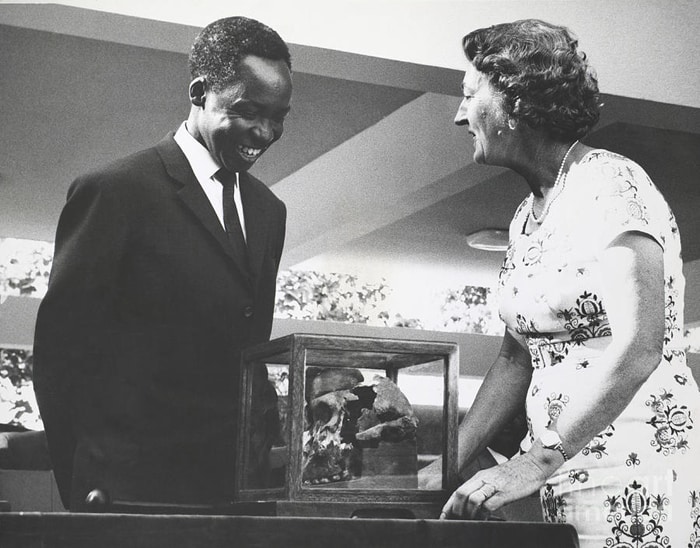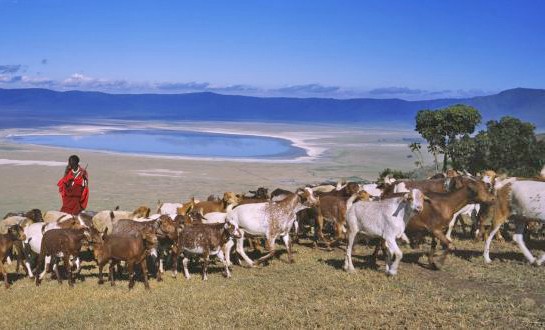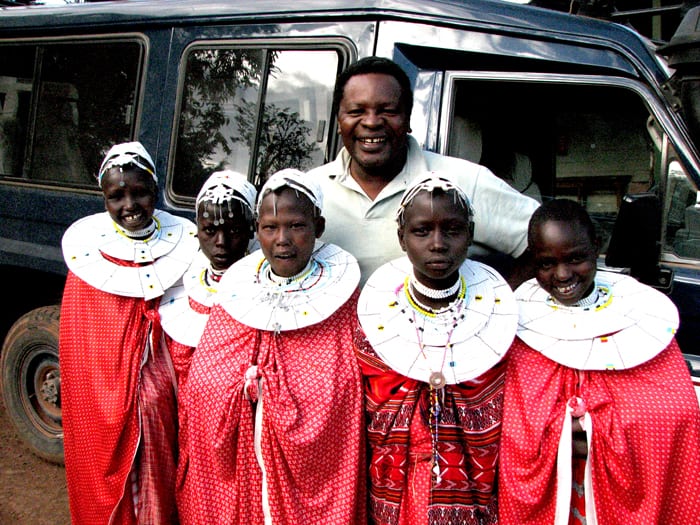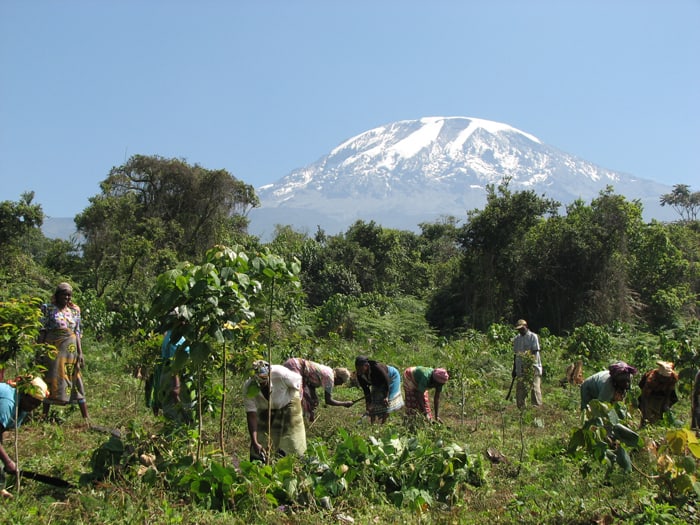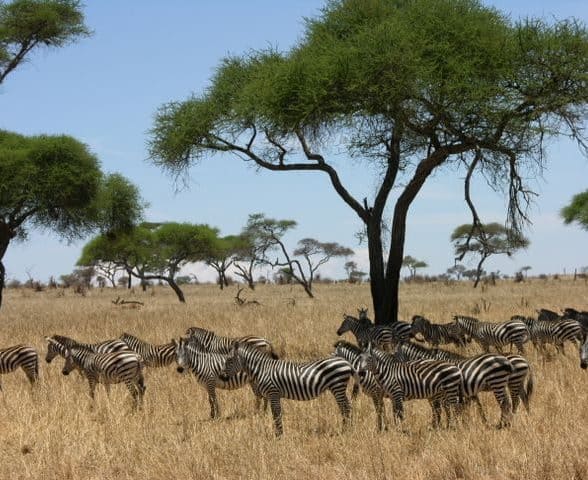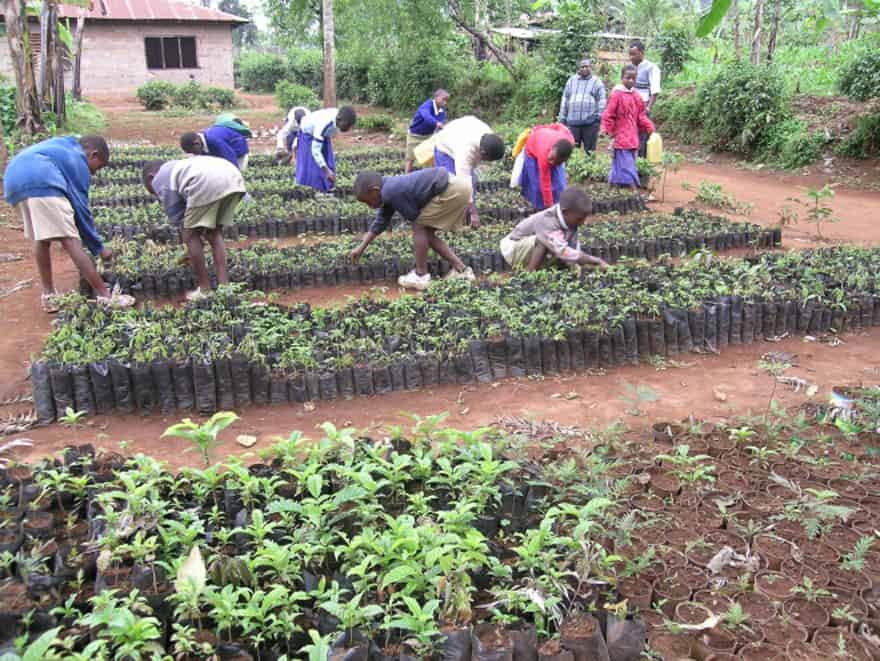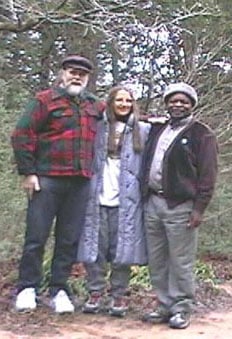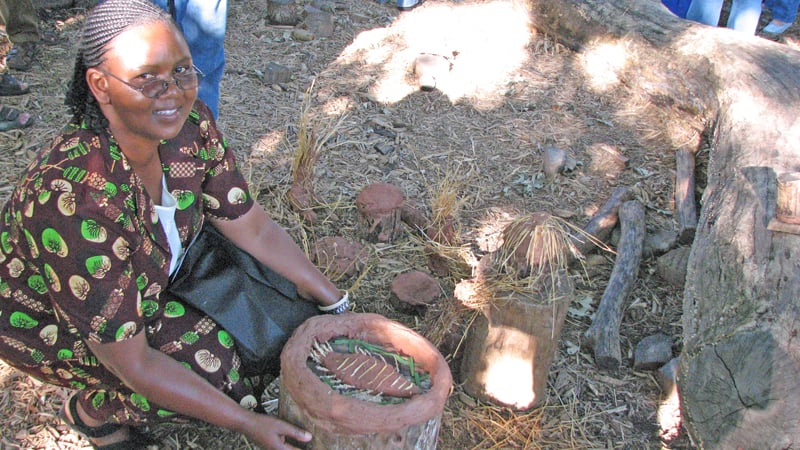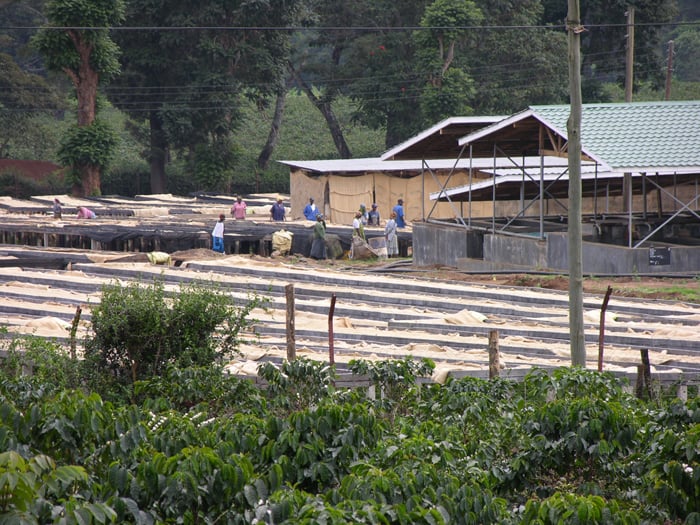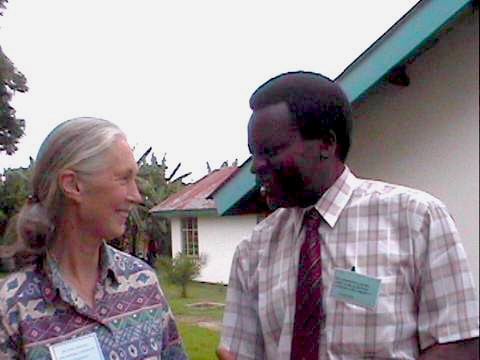Life of Sebastian Chuwa
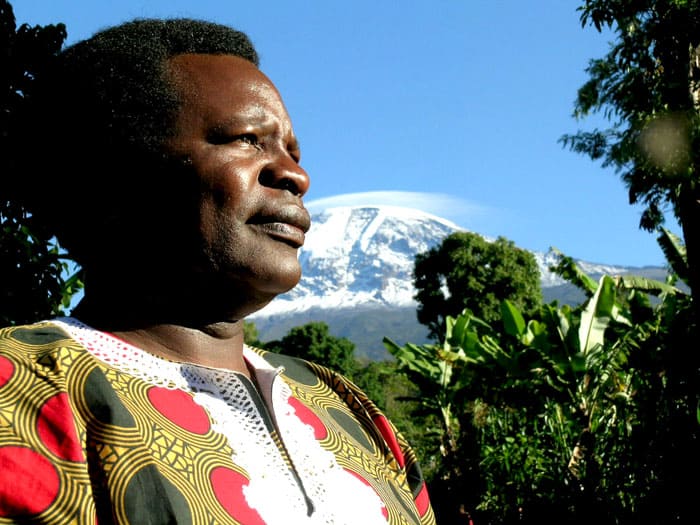
The African Blackwood Conservation Project was founded by Tanzanian botanist, Sebastian Chuwa and US woodturner, James Harris, in 1996. For almost 20 years, along with a wide group of volunteers, they worked together towards ensuring a future for African blackwood in its native land of Tanzania, and also sponsored many initiatives for the environmental sustainability of the Mt. Kilimanjaro watershed. Because of Sebastian’s considerable networking skills and wide influence in the conservation community, the groups influenced by his work were able to accomplish the planting of almost 3 million trees during his lifetime, and a generation of school children was exposed to the principles of environmental conservation. On April 8, 2014, Sebastian passed away from complications following a stroke. It was totally unexpected for his family, friends and colleagues. His legacy will be honored however, and the ABCP will continue his work. This page contains a history of Sebastian’s life and conservation activities in Tanzania.
Sebastian Chuwa
Sebastian Chuwa was a man with a vision for his country, his people, and the future generations who will inherit his legacy. Through many years of actively studying environmental problems in his east African homeland of Tanzania, he was often able to find broad-based solutions that could benefit not only the land, but the populations that depend on it for life and sustenance. His methods were based on the two primary foundations of: 1) community activism – organizing people to address their problems at a local level, and 2) youth education – influencing the teaching of conservation in schools, beginning at the primary level.
Using these two interlocking paradigms, he inspired large groups of community volunteers to come together to solve not only their environmental problems, but problems of poverty alleviation, women’s empowerment, and youth employment in the Kilimanjaro Region of northern Tanzania. His efforts on behalf of African blackwood created the first, and to date only, long-term replanting effort for the species. Because of the establishment of multiple community nurseries and numerous cooperative projects geared towards reforestation, the dedicated individuals inspired by his work accomplished the planting of close to three million trees, including mpingo along with a variety of other species. The ever-expanding nature of Sebastian’s efforts toward environmental remediation gave him and his community a reputation as leaders in the field of Tanzanian conservation.
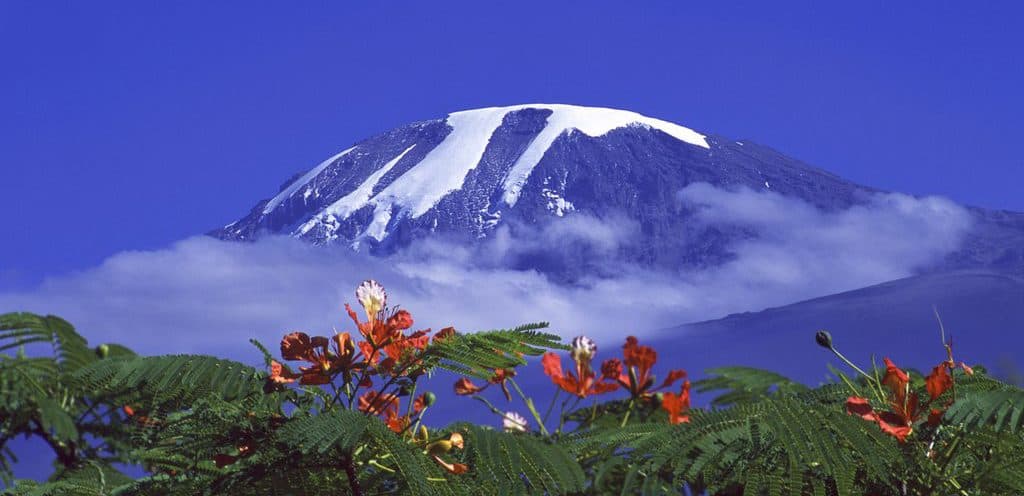
Mt. Kilimanjaro with snow-capped dome. Flowers in the foreground belong to the Delonix regia, or Flame Tree.
Childhood and Education
Sebastian Chuwa was born on June 11, 1954 in Sungu Village, Kibosho East Ward, in the Kilimanjaro Region of Tanzania, located at 4,900 feet in altitude on the southern slope of Mt. Kilimanjaro. His early inspiration for botanical pursuits came from his father, Michael Iwaku Chuwa, who was an accomplished herbalist and would take the boy along on forest trips whenever he went to collect medicinal herbs, teaching him names of plants and their medicinal and domestic uses. As an adult Sebastian compiled this information (see ‘List of Traditional Medicines’ in Environmental Conservation — Kibosho East, pg. 86), which had traditionally been secret, and published it for the utilization of the members of his community.
This inspiration from his father instilled in him a deep love and wide knowledge of the natural world and as a child he continually experimented with planting flowers, vegetables and trees in the family gardens and orchards. On completing his primary and secondary education, Sebastian determined to study conservation because this early exposure to nature had awakened in him a deep commitment to its future preservation. In 1972 he was awarded a government scholarship to attend the College of African Wildlife Management-Mweka in Moshi, Tanzania, one of the most prestigious wildlife institutes in Africa. He graduated in 1974 with a certificate in Wildlife Management.
Botanical Conservation at Ngorongoro Conservation Area
After graduating from Mweka, Sebastian secured a position as a Research Field Assistant at Ngorongoro Crater Conservation District in 1974, and worked there until 1991, advancing to the position of Assistant Conservator. During this employment he researched and documented vascular plant species of the Ngorongoro Basin, preparing separate lists of edible, medicinal and poisonous plants in the basin and discovering four new species, one of which was named in his honor. These included: Erlangea ngorongoroensis, Girardinia bullosa, Cyphostemma chuwa 2593 and Odontelytrum abssinicum. At park headquarters, he established a herbarium of 30,000 plants for the use of staff, scientists, and tourists. This collection was later divided, with half displayed in the National Herbarium in Arusha. He also collaborated in drawing up a new management plan for the conservation area.
During his botanical surveys, Sebastian gathered over 10,000 plants in duplicate to send to the University of Dar es Salaam and the Royal Botanical Gardens in Kew, England. Because of this work, he was awarded a scholarship by his government to study at Kew and received an International Diploma from that institution in 1990. His studies at Kew included plant identification, herbarium techniques, and the gardening of tropical wild plants.
Mary Leakey
In 1975 anthropologist Mary Leakey (in photo above), who worked with her husband Louis Leakey in early hominid research at Oldupai (renamed from the original Olduvai) Gorge which borders Ngorongoro, requested that the management staff of Ngorongoro “loan” her a botanist to identify the plants of the area. Sebastian was chosen and he spent extensive time at Oldupai in compiling an annotated checklist of the area’s vascular plants for Leakey’s use. The Leakey’s made important contributions to the knowledge of our human ancestry. In 1978 her team found the “Laetoli footprints” buried under volcanic ash, which have given us one of the earliest indicators for upright human posture.
The Endangered Black Rhinoceros
Sebastian also helped to institute a protection program for Ngorongoro’s endangered black rhinoceros, a target for poachers who sell the extremely valuable horns. Rhinos are fairly easily identified by the distinct characteristics of their individual horns so Sebastian kept a photographic file of rhino horns. In the 1980’s he was requested by authorities in Dar-es-Salaam to bring his file to help identify the source of rhino horns in a shipping case of 264 contraband horns that had been confiscated before being smuggled illegally out of the country. Using his photographs he was able to identify 8 rhinos that had been poached from the Ngorongoro protected area.
After this Sebastian insisted on the necessity of monitoring every individual rhino and set up a watch program, with a ranger assigned to personally supervise each rhino in the Crater. When the rhinoceros-monitoring program was published in the Ngorongoro Bulletin, it drew the attention of park personnel in other parts of Africa interested in ecological monitoring, and this type of protection project was adopted in other game parks.
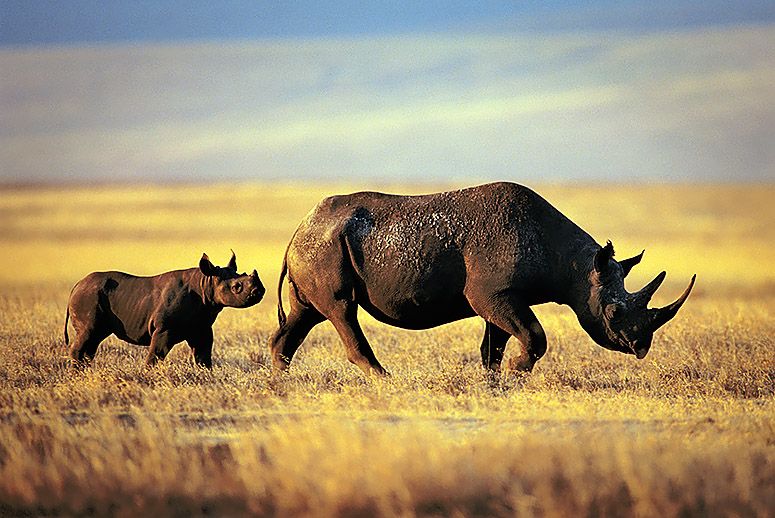
Maasai Pastoralists
In the 1970’s Sebastian also began organizing communities of Maasai pastoralists who lived around Ngorongoro (and depended on the park for water and forage for their cattle) to engage them in cooperative conservation endeavors. Through consultations with village leaders, he formed strong alliances and set up far-sighted programs. He gave them tree seedlings so that they would not cut trees in the crater and helped them establish their own tree nurseries. Many people in the area now have their own trees for fuelwood and timber, thereby reducing tree-cutting in the conservation area. In 1981 he inspired the establishment of the first youth club in Tanzania for environmental education, set up in a Maasai school, the Ngorongoro Crater Primary School. This club focused on conservation education, managing tree nurseries and replanting native species back into the environment. During this period he met British botanists David Bygot and Jeannette Hanbey, who were doing research in Ngorongoro, and contributed his knowledge of local wildlife to a book they published, entitled Ngorongoro Conservation Area: The Complete Guidebook.
Further Training
In 1992 Chuwa traveled to Uppsala University in Sweden for a workshop called “Participatory Rural Appraisal Program,” which focused on organizing and implementing projects at the community level. A GIS course at the Ardhi Institute in Dar es Salaam gave him the training needed to prepare Vegetation Species Composition Maps of Ngorongoro Crater area, Tarangire National Park and Udzungwa National Park. He also participated in various forest surveys in different parts of Tanzania to contribute information for inclusion in an atlas of vegetation of Tanzania. In the Democratic Republic of the Congo he participated with other scientists in biodiversity reconnaissance surveys and was also a consultant for the National Museum of Kenya in identifying plants for their herbarium.
Wildlife Conservation Society
In 1991 Sebastian left his employment at Ngorongoro to work as a botanical officer at the Wildlife Conservation Society of Tanzania (WCS) in Dar es Salaam. There he was in charge of coastal forest projects and established several youth conservation clubs that are still active. He also continued his tree nursery work and raised and distributed more than 78,000 seedlings like mpingo, red mahogany and pod mahogany. During this employment, because of his keen interest in replanting programs for African blackwood, he was interviewed and used as consultant in 1992 by the BBC for the Nature series documentary “The Tree of Music.”
In 1992 Sebastian left the WCST and returned to his ancestral home on Mt. Kilimanjaro. Between 1992 and 2010 he was employed by Wildlife Explorer-Tanzania as a seasonal botanical and wildlife safari guide. During his free time at home, Sebastian, in association with his wife, Elizabeth Chuwa, a primary school teacher, organized tree planting and educational activities in the Mt. Kilimanjaro Region. In 2010 he retired from safari work and devoted the remaining years of his life to conservation.
Tree Planting and Education in Kilimanjaro Region
Degradation of Mountain Water Sources
When Sebastian returned to Kilimanjaro in 1992, he was appalled and saddened by the widespread environmental degradation in his homeland. His years away had seen the collapse of its coffee industry which had been established by European settlers in the late 1800’s and was the major income earner in the area. The resulting poverty had led to widespread tree cutting and numerous indications of environmental damage. Sebastian often remembered that when he was a young boy there were so many trees everywhere that from many vantage points you could not even see the peak of Kilimanjaro through the dense tree canopy. But because of years of land degradation and reduction of forest cover, its summit had become visible from all areas of the mountain. Rivers that once flowed all year became seasonal and others stopped flowing altogether. Realizing that he could obtain little assistance from the impoverished government of Tanzania, Sebastian determined to organize and educate communities on the mountain to find ways of self-action that could reverse the decades of environmental decline and improve standards of living. As a first step he established a nursery in his own backyard, where he grew tree seedlings that would offer economic benefit for the people and simultaneously reforest the mountain.
Kilimanjaro Conservation Groups
Sebastian and Elizabeth pinpointed education as a primary objective, focusing many programs on teaching youth the advantages of rightful care of their environmental inheritance. Therefore their methodology became an integrated three-fold approach of tree planting, education, and self-help initiatives, resulting in the intertwined objectives of environmental remediation and poverty alleviation. This outreach struck a responsive chord in the mountain communities who knew that their future livelihoods depended on the viability, health and diversity of nature itself. Through efforts to combat pollution, reforest the mountain and educate their fellow citizens about conservation, they implemented programs that helped to remedy damage that had been caused by many decades of environmental abuse.
Environmental Education
To inspire young people with proper ideas of environmental care and nurturance, Sebastian and Elizabeth enlisted the aid of primary and secondary teachers in Kibosho East, the district of Kilimanjaro where they lived. They organized a conference where teachers collaborated in creating a curriculum that would incorporate environmental studies into school activities. Because of expenses of travel and entry permits, many of these teachers had never visited the national parks of Tanzania, and consequently had never actually seen much of the magnificent animal and plant life of eastern Africa. To remedy this, instructional safaris were arranged so that they could tour Lake Manyara, Ngorongoro Conservation Area and Serengeti National Park. The trips gave them a knowledge and excitement about conservation that they could impart to their students. Similar safaris were arranged for student groups so that young people themselves could experience the excitement of learning to identify wildlife firsthand and become aware of the problems of endangered species. With knowledge garnered from these expeditions, students were able to communicate information and enthusiasm about protecting the environment to their families and contacts within their local communities.
Youth Conservation Groups
Sebastian and Elizabeth further extended their outreach through affiliation with two national youth organizations, Malihai Clubs of Tanzania and Jane Goodall’s Roots and Shoots. These organizations provide students further opportunities to study conservation and to personally assist in environmental remediation projects. With a holistic approach they train young members to understand the living communities in the African ecosystem and the conditions needed for them to successfully coexist. Club members learn a variety of skills, including environmental and personal hygiene, knowledge about natural ecosystems and group cooperation. They are instructed in beautification and cleanliness of the area around their homes and schools and practice personal hygiene and household sanitation to offset public health problems like cholera and other epidemics. Through sports activities such as volleyball and basketball they learn physical coordination and cooperation.
One of their most important activities is establishing tree nurseries on school grounds. Each club is directly responsible for planting tree seedlings which are then transplanted to areas around schools and homes, or into the surrounding ecosystem. Every year Malihai and Roots and Shoots Clubs all over Tanzania replant many thousands of trees. Elizabeth and Sebastian have helped in the founding of over 100 youth clubs, with membership of up to 300 students each. Their formation has enhanced good co-operation among the schools, villagers, and various institutions in Kilimanjaro Region. During the 1990’s the national Malihai network had about 1,000 clubs registered with the national office with 200,000 Tanzanian students introduced to environmental education every year. Roots and Shoots is an international network, with branches in numerous countries.
Sebastian and Elizabeth, in affiliation with the ABCP, also supported several adult conservation groups, each involved in planting trees and sponsoring initiatives for environmental protection. Some of these groups are: the Green Garden Women’s Group, The Kibosho East Environmental Group, the Mpingo Women’s Group at Kikavu chini, the Fonga Women’s Group and the Environmental Greenishing Groups. See the Community Groups page to see a description of the work of these groups.
Rafiki Friends Foundation
Sebastian was assisted in these early efforts by the California-based Rafiki Friends Foundation, a group organized by US travelers who had met Sebastian as a safari guide and wanted to help with his environmental work. Visits to the awe-inspiring national parks of Tanzania inspired them to initiate fund raising activities to support education in Tanzania and to promote awareness of the need to preserve Africa’s wildlife. To this end the Rafiki’s organized fundraising efforts in the US for the advancement of youth education in the Moshi and Arusha areas of northern Tanzania. These efforts refurbished schools and provided desks and school lunches in several different communities. They supplied Malihai Groups with used computers, pens, pencils, paper, crayons, sports gear, environmental books and herbarium equipment.
The African Blackwood Conservation Project
Sebastian loved all trees and considered each as having a special niche, but his special love for mpingo was obvious to all who knew him. Sadly, he had personally witnessed in his own lifetime the commercial extinction of this irreplaceable tree in his ancestral area of northern Tanzania. Because of this he was keenly aware of the paramount importance of replanting and protecting the species today so that there will be trees for tomorrow. Above all he knew the danger of waiting until a species has so declined that its genetic diversity has been compromised.
James Harris and Sebastian Chuwa founded the African Blackwood Conservation Project in 1996 with the objective of inaugurating educational and replanting efforts for the botanical species Dalbergia melanoxylon, known as mpingo in its home range of eastern Africa. The two were brought together by the PBS sponsored documentary, The Tree of Music, in which Sebastian is featured. When James, who used African blackwood in his woodturning, saw The Tree of Music video he determined to do something for the conservation of the species. He made contact with Sebastian by mail and proposed a joint effort: he would launch a fundraising campaign among woodworkers, musicians and conservationists of the western world, and send the money to Sebastian to start propagation and distribution of the species. The project was enthusiastically endorsed by Sebastian. Since that first contact, the ABCP has become a leading force for mpingo conservation in northern Tanzania, producing large numbers of mpingo seedlings and raising awareness about the importance of the species internationally.
The history, projects, supporters and affiliations of the African Blackwood Conservation Project is documented on various pages on this website. See Awards page for preview of environmental awards presented to Sebastian and the ABCP.
The Nature Action Collaborative for Children
In 2008 Sebastion was invited to be on the leadership team of the Nature Action Collaborative for Children (NACC), an organization dedicated to reintroducing nature activities into the daily lives of children. Sponsored by the Arbor Day Foundation and World Forum Foundation, the NACC was inspired by a seminal paper written by Mary and John Rosenow (President of the Arbor Day Foundation) entitled “Helping Children Love the Earth Before We Ask Them to Save It.” In July 2008 Sebastian and Elizabeth traveled to Nebraska City, Nebraska to attend a NACC conference on early childhood education.
The objective of the conference was to share ideas and methodology about re-introducing nature activities into the daily lives of children. In developed countries particularly, children are ever less likely to grow up climbing trees, collecting flowers and bugs, and getting dirty playing in the backyard. Instead of experiencing the wonder of nature firsthand and watching its recurring cycles of growth, death, and rebirth, increasing societal pressures and fears are confining children to indoor spaces, often to spend hours each day watching TV or playing video games on computers. Ironically, the news that children often get from TV about the environment concentrates on subjects such as global warming and endangered species rather than its beauty. Educational researchers are now becoming alarmed and have coined a new word, “ecophobia,” used to denote fear of the natural world and environmental issues, often arising from exposure to negative images of nature at too early an age. Conference participants shared ideas on how to give children early experiences of nature to awaken their wonder and love, thereby learning to identify and bond with nature at an early age, hopefully to become good stewards of the environment as adults.
In 2008 they attended a World Forum Foundation conference in Belfast, Ireland with the objective of creating a global exchange for early childhood care professionals to exchange ideas and promote quality education for children in diverse settings. Sebastian moderated a forum entitled, “Bringing Nature into Indoor Classrooms.” One project demonstrated was the gathering and analysis of woodland mushrooms, teaching students to distinguish between edible and inedible types.
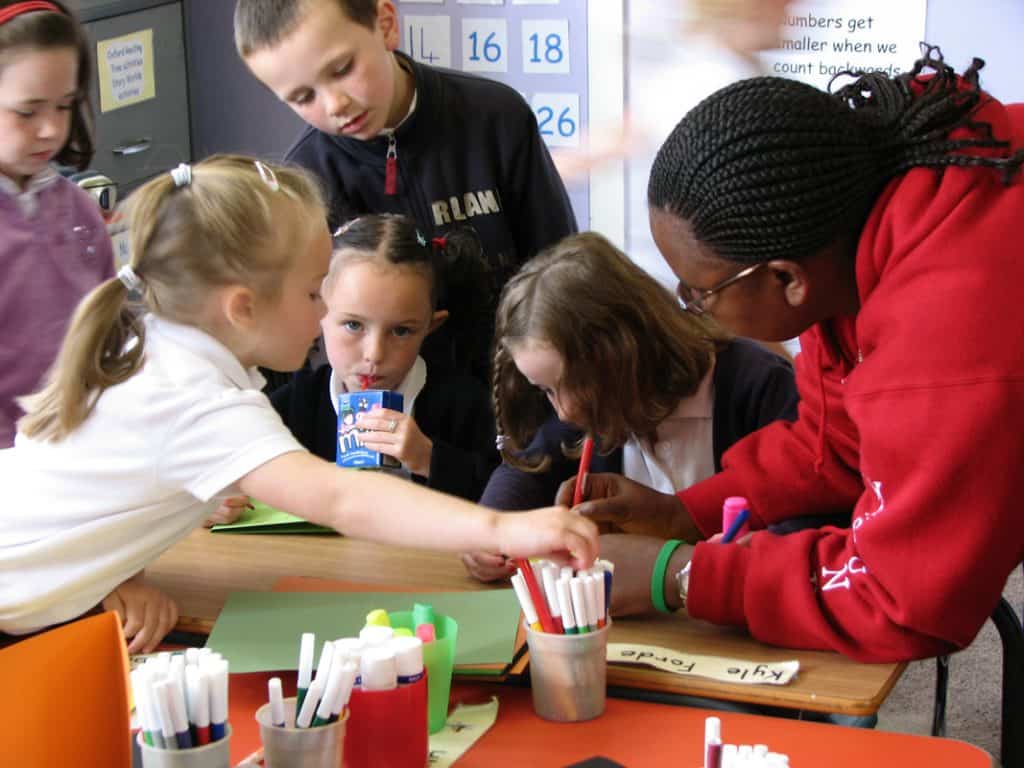
Coffee Farmers of Kilimanjaro
Coffee is Tanzania’s largest export crop, contributing about US $186 million (2014) to export earnings. Almost 90 percent of the crop is grown by smallholders, and about 75,000 coffee farmers live on Mt. Kilimanjaro. The Arabica coffee they produce is widely known for its flavor. However, following local downturns in this sector researchers have been experimenting with producing more resilient and productive trees. In 1998 the Government of Tanzania launched a Coffee Revival Program in an effort to replace old and disease-prone trees with new resistant varieties developed at its Tanzania Coffee Research Institute (TaCRI) at Lyamungo, located on Mt. Kilimanjaro.
TaCRI launched a nation-wide effort to boost coffee production in regions of the country where it grows well. To this end they have developed 23 new hybrid varieties that combine good yield and quality with resistance to Coffee Leaf Rust, Coffee Berry Disease and Coffee Wilt Disease, the three maladies that are destroying crops. Some of the new varieties bloom early so that during the long rains the fruit is mature enough to resist both disease and cold weather, which kills young berries.
By 2016 it had produced over 51 million hybrid seedlings, enough to replant 20% of the coffee area of Tanzania. In order to achieve a widespread range of contact and distribution of the new varieties, it established a network of 400 farmer groups, each of which would manage a nursery to produce the hybrid coffee plants and make them available to farmers in the local area, These participants were trained in grafting and clonal propagation techniques that produce a quickly maturing plant.
Sebastian worked with TaCRI in introducing the new varieties to coffee farmers in Kibosho East. The trees, which are planted from cuttings, start bearing within 2 years (compared to 5 years if planted from seed). Mother trees were planted in the nursery of ABCP project partner Kibosho East Environmental Group, and cuttings from the trees were planted in pots until mature enough to be replanted in farmers’ fields. Sebastian distributed over 20,000 trees and personnel from TaCRI often brought visitors and groups to tour the KEEG plot. Local initiatives like this are of importance for the Tanzanian government in achieving its goal of re-energizing the coffee sector.
Shade-grown Coffee
Estimating that only one percent of Kilimanjaro coffee farmers were currently growing resistant varieties, Sebastian also began to do educational outreach, working with small local groups teaching them the basics of coffee cultivation and care so that they could educate other people in the area about horticultural methods and begin replacing their disease-prone trees with new varieties, organically grown. He also produced an organic pesticide/fertilizer combination for coffee trees made from Tephrosia, marigold, clay soil and manure tea and then fermented for 10 days. This combination is a powerful pesticide, not only for coffee pests and leaf rust, but also for those of other crops.
Shade-grown coffee is ecologically friendly and protects biodiversity and animal and insect populations. Since much of Kilimanjaro coffee is shade-grown and therefore dependent on other tree species to provide the needed shade, part of Sebastian’s outreach has been to help provide organic shade tree seedlings. These were selected from hardwood species that can supplement the smallholder’s resource base with important domestic products (such as fuelwood, timber, fruit and nut trees), and thereby reduce vulnerability to fluctuating market prices and crop failure. Sebastian’s formula for numbers of trees planted on shade grown coffee farms used the ratio of 15 hardwood trees and 20 banana plants for every 50 coffee trees. Some of the hardwood species distributed from the nursery were: Macaranga kilimandsharica, Podocarpus latifolius or Yellow wood, Grevillea robusta or Silk oak tree, Albizia kilimandsharica and Rauvolffia cafra or Wild mango tree.
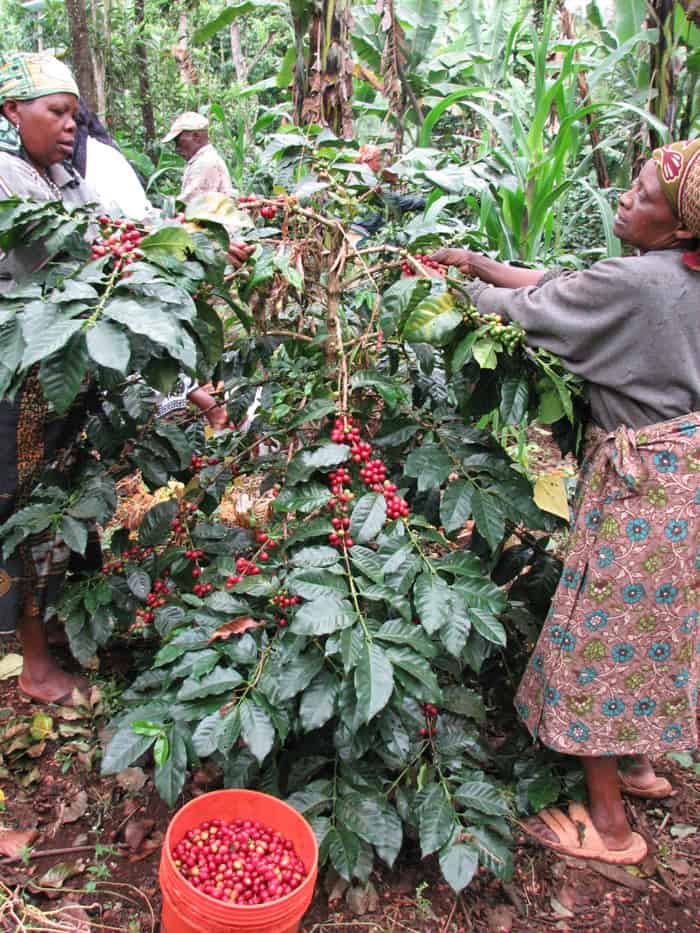
Conferences, Offices, Awards
Conferences
Sebastian delivered a number of addresses about conservation during conferences he attended.
In 2000 he attended a conference on “Wildlife Management in the New Millennium” at the Mweka College of Wildlife Management. He spoke on mpingo conservation and during the conference met with Jane Goodall, the keynote speaker, to discuss their respective youth programs. They are shown in conversation after Dr. Goodall’s talk in the photo at left. After this meeting Sebastian was active in helping to establish Goodall’s Roots and Shoots clubs in the Moshi and Arusha areas.
At a regional conference of Malihai sponsors, he shared his ideas about youth education and was able to interest other participants in mpingo replanting efforts.
UNEP – He also attended an “Environmental Action Learning” seminar sponsored by the United Nations Environmental Programme (UNEP), again presenting his ideas. As a result of this seminar he worked with 5 colleagues to draw up a plan for environmental education programs in the schools of Tanzania.
During the 1990’s Fauna and Flora International (FFI) took a leading role in investigating certification and sustainable harvesting practices for mpingo. In October of 2001, FFI held a conference in Dar es Salaam, bringing together government representatives, foresters, artisans, and conservationists to discuss a way forward for the species and Sebastian was given an opportunity to present his ideas about mpingo conservation and the work of the ABCP.
In May of 2002 he attended the High Summit Conference for Africa in Nairobi and gave a talk on conservation on Mt. Kilimanjaro. This conference was held as part of the UN designated 2002 International Year of the Mountains celebration.
Sebastian delivered educational addresses at numerous other organizational meetings and public gatherings about topics related to the benefits of environmental conservation and protecting the mpingo tree.
Offices and Awards
During his association with the ABCP, Sebastian received several prestigious international awards in order to acknowledge and honor the important work he was doing in the field of conservation. These are noted below.
Rolex Awards for Enterprise – November, 2002: Sebastian was the recipient of an Associate Laureate Award from the Rolex Awards for Enterprise committee. In ceremonies held in London, England, he was presented with a gold Rolex watch and a cash award. This funding served to expand the work of the ABCP, enabled it to greatly enlarge the ABCP mpingo nursery and afforded Sebastian the means to purchase an all-season 4wd vehicle.
Arbor Day Foundation J. Sterling Morton Award – June, 2007: Sebastian receives the J. Sterling Morton Award, the highest yearly award of The National Arbor Day Foundation, presented during ceremonies in Nebraska City, Nebraska. Bette and James traveled to Nebraska City for the awards ceremony and spent several days with him consulting about the future direction of the project.
Spirit of the Land Award – February, 2002: During Winter Olympics ceremonies at Salt Lake City, Sebastian received the Spirit of the Land Award, presented to 10 US and 5 international conservationists who made outstanding contributions in the field of environmental education.
Conde Nast World Saver’s Award – November, 2006: Sebastian was chosen as one of 3 international environmentalists for a “World Savers” Award, presented by Conde Nast Traveler magazine to “an unsung few who are fighting to safeguard some of the globe’s most spectacular destinations, which for these heroes also happen to be home.” The award was given to honor his work for the conservation of Mt. Kilimanjaro.
Councilor of Kibosho East – October, 2000: Sebastian was elected to political office as Councilor of his ward of Kibosho East. This position gave him a voice in local and central government and facilitated his efforts to coordinate and encourage various environmental initiatives and tree planting campaigns.
Chairman of Kilimanjaro Environmental Conservation Management Trust Fund – 1999: Sebastian was appointed Chairman of the Kilimanjaro Environmental Conservation Management Trust Fund by the Regional Government Authority of Kilimanjaro Region, Tanzania. This office gave him membership in the Regional Environmental Conservation Committee.
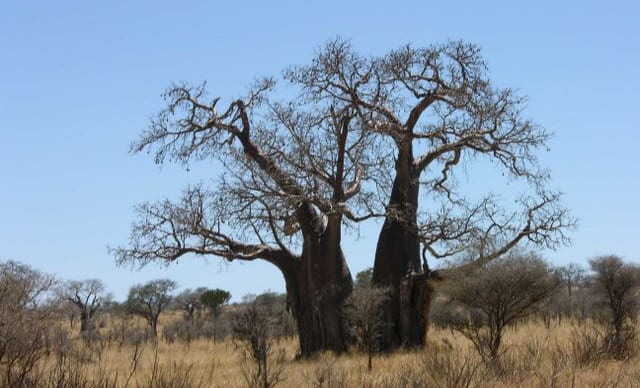
Baobabs tower above other tree species on the east African savannah.

